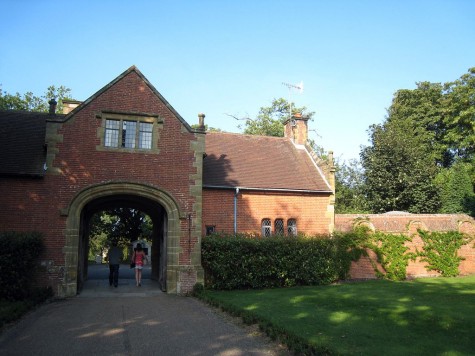Down the walk, the castle gradually emerges from behind the trees.
The gardens have a large collection of sculpted topiary. I like the idea of topiary, but I sometimes puzzle what the shapes are supposed to be.
The variety of shapes leads me think about the natural growth from which the sculptors start.
The castle is surrounded by a moat. Moats were designed as physical barricades against invasion, so having an clean and attractive body of water around a castle is purely an aesthetic feature.
Behind the castle is the Astor Wing, where weddings and meetings might be held. The castle was acquired and restored by William Waldorf Astor in the early half of the 20th century.
A drawbridge spans the moat at the front gate. I doubt that drawbridge gets pulled shut a night.
The thickness of the outer wall can be seen through the front gate.
Through the gate is a courtyard. The castle was acquired and converted to become an tourist attraction in the 1980s. Unfortunately, photography of the 16th century furnishings and paintings — plus some swords and instruments of torture — aren’t permitted.
Hidden on the inside, but visible as windows on the outside is a hidden chapel. Catholics may have been less welcomed after the Church of England split under Henry VIII.
The grounds outside the castle could take as long as inside. Maybe really long, if we had tried out the maze.
We stayed outside the maze, and didn’t enter another entry that we found, either.
In the hedges of the Tudor Garden, an arch has been sculpted to give a view inside.
Through the arch is a chess set.
In the Italian garden is a fountain.
We continued walking through the garden, down the walk.
At the end of the walk, there’s a lake.
Looking the other direction along the stream is Tudor Village, originally built by Astor for guests and staff. Tourists aren’t welcome back there.
The trellis beside the stream continues the atmosphere of privacy.
As we headed back towards the front gate, I noticed some statues by the hedges.
We were late in the day, so the attraction was starting to close its gates.
A short walk from the castle, the steeple of St. Peter’s Church is prominent.
Unlike the castle, this church is active.
The grounds have been sacred for longer than this building has been in place.
The church was empty. It’s not a large building. The stained glass and altar were well featured.
As is common in English churches, there are tombs inside.
The inscription on top of the tomb dates back centuries.
Down the road from the castle and the church in Hever, we had stopped for lunch at the Henry VIII Inn.
I don’t frequent pubs, so I’ve never seen a washer where the glass is pressed on top of a spout of water. Following the English practice, we placed our orders at the bar.
Since the weather was fine, we had our lunch outside. On weekends, it would seem that pubs can be family venues. We watched some children playing mother-may-I.
Across from the Inn is a field. We noticed some beacons erected there.
A plaque on the post read: “This beacon was erected and first lit on 8th May 1995 to commemorate the 50th anniversary of V.E. Day”.
The English are good at preserving history — not only for decades, but for centuries.

